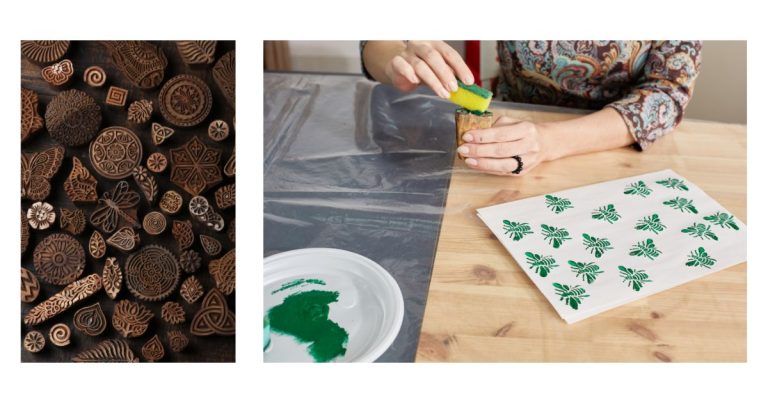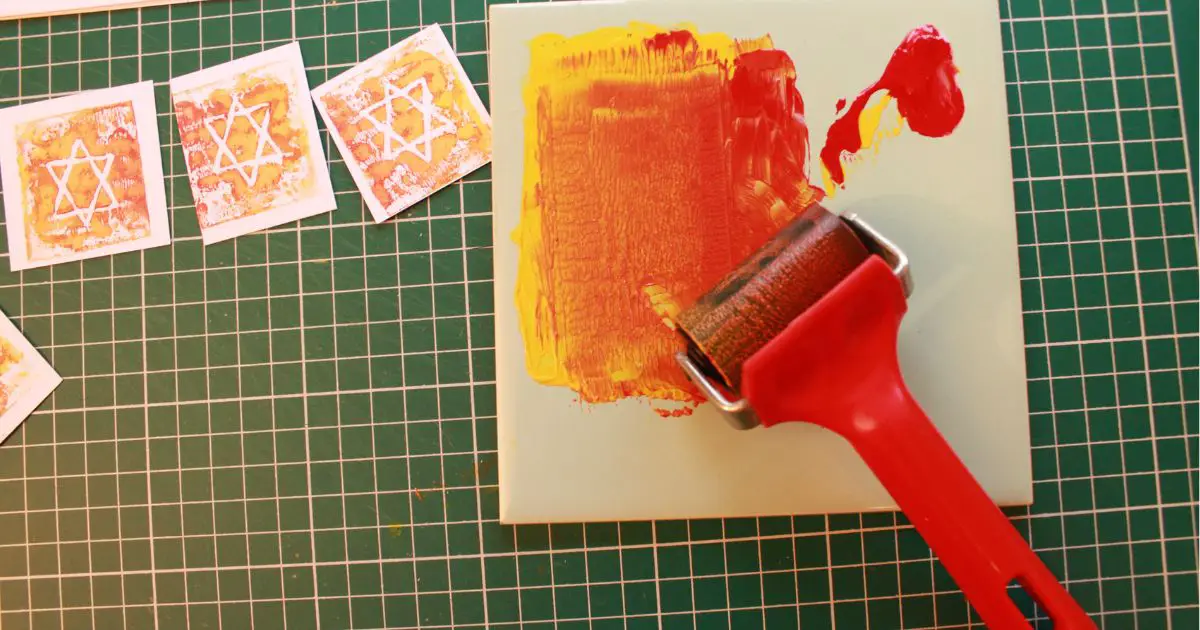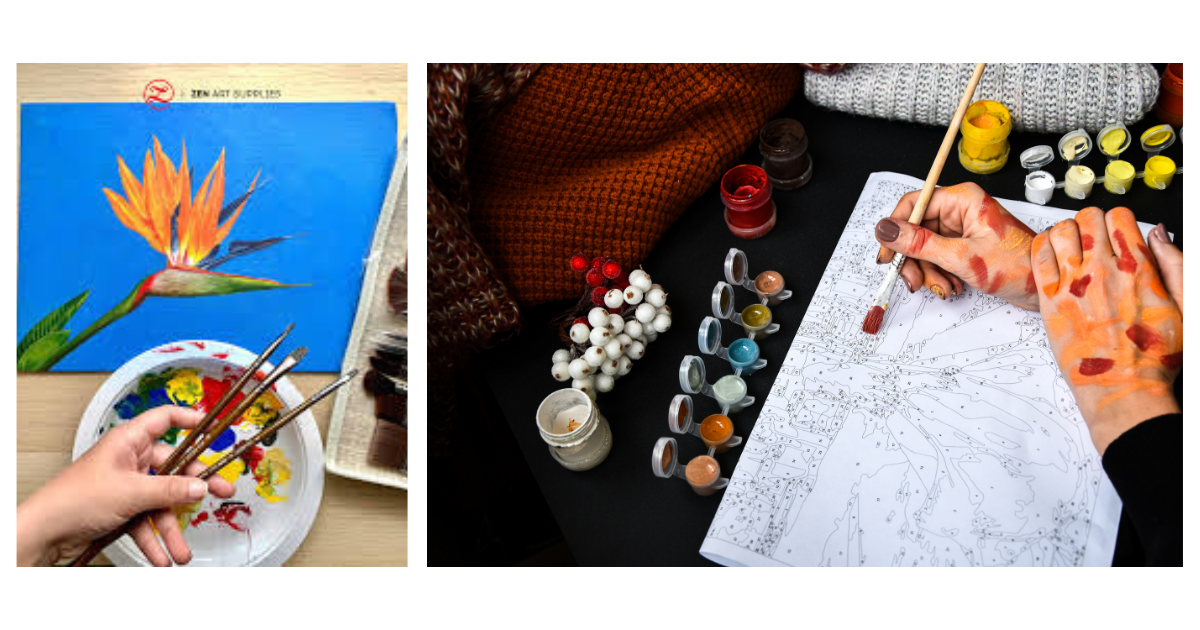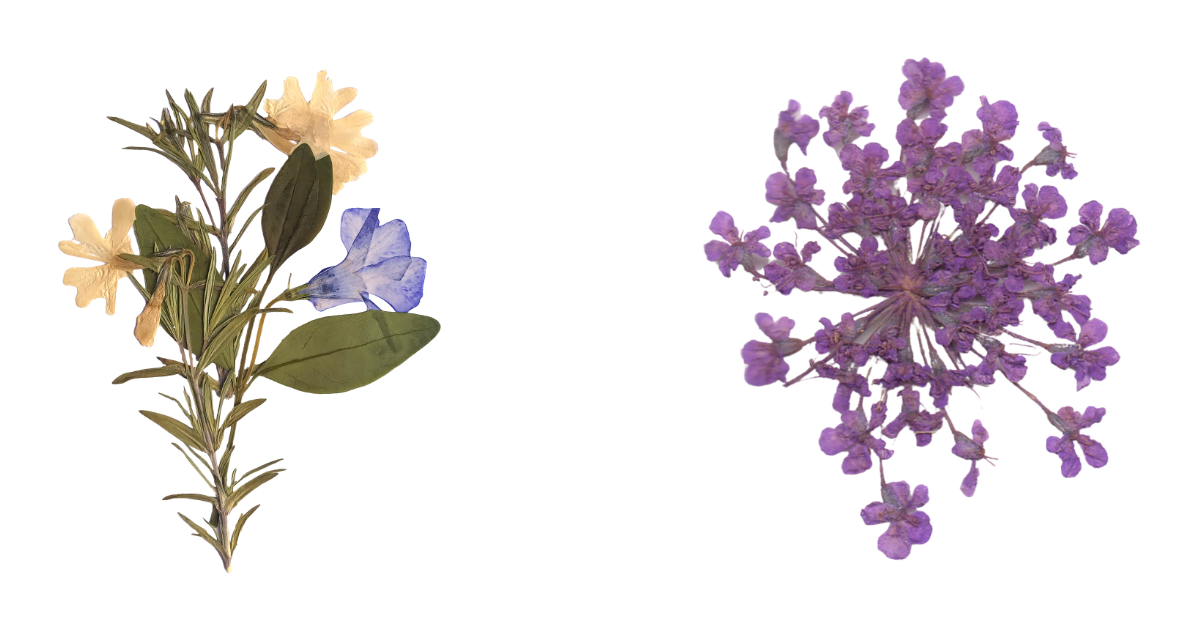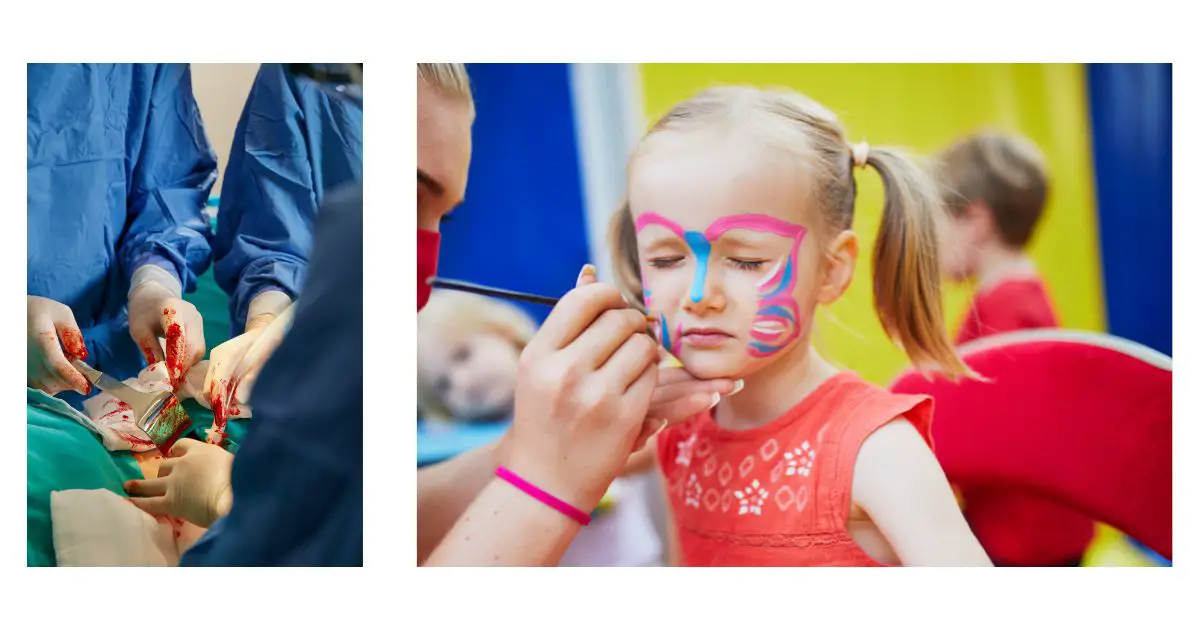Yes, you can use acrylic paint for block printing. It is a versatile medium that can be used on a variety of surfaces. Acrylic paint dries quickly and is available in a wide range of colors, making it a good choice for those who want to create detailed designs.
- Decide on the design you want to create
- Sketch your design onto a piece of paper or directly onto the block
- Carve out your design using a sharp knife or linoleum cutter
- Apply paint to the raised portions of your carving using a brayer or roller
- Press your paper firmly onto the block and roll over it with a brayer or roller to transfer the paint from the block to the paper
- Remove your paper from the block to reveal your printed image!
Block Printing with Acrylic Paint
What Paint to Use for Block Printing on Paper
There are a few different types of paint that can be used for block printing on paper. The most common and easiest to find is acrylic paint. This paint is available in many colors and can be easily cleaned up with soap and water.
Another type of paint that can be used is oil-based paint. This type of paint will require mineral spirits or turpentine for cleanup, but it can give your prints a more polished look.
What Paint to Use for Block Printing on Fabric
Block printing is a popular printing method for fabric. It is a relatively simple process and can be done at home with some basic supplies. The most important part of the process is choosing the right paint for your project.
There are a few things to consider when selecting paint for block printing on fabric. The first is the type of fabric you will be using. Different fabrics require different types of paint in order to adhere properly and achieve the desired results.
Cotton, linen, and other natural fibers work well with water-based block printing inks or dyes. Synthetic fabrics like polyester or nylon require special heat-set inks that won’t wash out in the laundry. The second thing to consider is the color of paint you want to use.
Block printing inks come in a wide variety of colors, so you can choose whatever shade you like best. You can also mix colors together to create custom hues. When mixing your own colors, be sure to use a ratio of three parts dye to one part water so the ink isn’t too runny.
Finally, think about how much paint you need for your project. A little goes a long way with block printing, so start with a small amount and add more as needed. It’s always better to have too much paint than not enough!
Now that you know what kind of paint to use for block printing on fabric, it’s time to get started on your project! Choose your favorite design, gather your supplies, and let your creativity flow!
Block Printing Ink Vs Acrylic Paint
There are a few key differences between block printing ink and acrylic paint that you should be aware of before deciding which is right for your project. Acrylic paint is water-based, while block printing ink is oil-based. This means that acrylic paint will dry more quickly than block printing ink, and it can also be thinned with water if necessary.
Block printing ink is more durable and thick, so it won’t run or bleed as easily as acrylic paint. However, because it’s oil-based, it can be difficult to clean up if you make a mistake. When it comes to price, block printing ink is usually cheaper than acrylic paint.
However, both are relatively affordable compared to other types of art supplies. Ultimately, the decision of which to use comes down to personal preference and the specific requirements of your project.
Can You Use Acrylic Paint for Lino Printing
Acrylic paint is a versatile medium that can be used for a variety of art projects, including lino printing. Lino printing is a type of relief printing in which the image is carved into a piece of linoleum and then inked and transferred to paper. While you can use any type of paint for lino printing, acrylics are a good option because they’re easy to work with and clean up.
Plus, they come in a wide range of colors so you can create whatever design you like. Here’s what you need to know about using acrylic paint for lino printing. When choosing an acrylic paint for lino printing, it’s important to select one that has good coverage and adhesion.
Look for an opaque paint that will evenly cover the surface of your lino block. You’ll also want to make sure the paint adheres well to the surface so it doesn’t peel or flake off when you’re carving your design. Once you’ve selected a suitable paint, thin it down slightly with water so it’s easier to apply evenly across the surface of your block.
To transfer your design onto the lino block, first sketch it out on paper or trace it onto transparency film. Then place the tracing over the block and secure it in place with masking tape. Using a sharp knife or gouge, carefully carve out your design following the lines on your tracing.
Be sure to go slowly and take care not to cut yourself! Once your design is carved, it’s time to ink up your block. Place your block face-down on a sheet of paper or foam board and rub ink evenly across the surface using a brayer (a roller specifically designed for printmaking).
Make sure all areas are covered with ink before flipping the block over and pressing it firmly onto your paper or fabric item. Lift up carefully to reveal your printed image!
Acrylic Block Printing Medium
Acrylic block printing is a type of printmaking in which an acrylic block is used as the matrix. The block is carved or otherwise marked with the image to be printed, and then ink is applied to the surface of the block. The block is then pressed onto paper or another substrate, resulting in a transfer of the image.
Acrylic blocks can be carved using a variety of tools, including knives, chisels, and gouges. The surface of the block can also be etched using acid or abraded with sandpaper or other abrasives. Once the desired image has been created on the surface of the block, it can be inked up using a brayer or roller.
The inked surface can then be transferred to paper or another substrate by pressing down on the back of the paper with even pressure. Acrylic block printing is a versatile medium that can be used to create detailed images or bold graphics. It can also be used for printmaking techniques such as monotypes and monoprints.
What Paint to Use for Lino Printing
When you are lino cutting, it is important to use the correct type of paint in order to achieve a successful print. There are a few different types of paint that can be used for this printing technique, but not all of them will produce the same results. Here is a brief guide on what paint to use for lino printing:
Oil-based paints are the most common type of paint used in lino printing. They are easy to work with and provide good coverage. However, they can take longer to dry and may require thinning before use.
Water-based paints are another option and they dry more quickly than oil-based paints. They can also be thinned if necessary. Acrylic paints are similar to water-based paints, but they provide better coverage and durability.
They are also available in a wide range of colors.
Block Printing on Fabric Step by Step
Block printing is a form of relief printing that has been used for centuries to create beautiful designs on fabric. The process is simple and can be done at home with just a few supplies.
Here are the steps for block printing on fabric:
- Choose your design. You can either create your own or find a pre-made stencil or stamp. If you are creating your own design, start by sketching it out on paper first. Then transfer the design onto your block using carbon paper or a tracing method of your choice.
- Cut out your design. Once your design is transferred onto the block, use a carving tool to cut away the excess material around the edges of the design. Be sure to work slowly and carefully so you don’t accidentally damage the block or remove too much material.
- Ink the block. Use an ink pad or brush to apply ink to the raised portions of yourblockprintingstamporstencil. Make sure all areas are evenly covered with ink before moving on to the next step.
- 4.,5.,6.,7.,8.,9 Press firmly but smoothly over the top of the muslin fabric square, holding the stencil in place while applying even pressure with a brayer Wipe off any excess ink from both sides of the screen before peeling back to reveal the print. Repeat these steps until the desired pattern is achieved!
Textile Medium for Acrylic Paint
If you’re looking for a versatile medium to use with your acrylic paint, then look no further than textile medium! This medium can be used on a variety of fabric surfaces, and it will give your paint a nice, even finish. Plus, it’s easy to work with and clean-up is a breeze.
Here’s everything you need to know about using a textile medium with your acrylic paint. What is a textile medium? Textile medium is a liquid additive that you mix with acrylic paint before painting on fabric.
It helps the paint adhere to the fabric better and also makes the paint more flexible once it dries. This makes it less likely to crack or peel over time. How do I use textile medium?
Simply mix the textile medium into your acrylic paint at a ratio of 1:1 (one part textile medium to one part paint). For example, if you’re using 2 ounces of paint, then add 2 ounces of textile medium as well. Once mixed, apply the paint to your fabric surface as usual.
What are some tips for using textile mediums? Here are a few tips to keep in mind when using this product:
- Be sure to wash and dry your fabric before painting it.
This will help remove any oils or dirt that could prevent the paints from adhering properly.
- If you’re working with dark colors, consider pre-washing the fabric in order to avoid any potential staining issues.
- Allow plenty of time for the paint to dry completely before handling or laundering the item (follow the instructions on your specific type of textile medium).
Can You Use Poster Paint for Lino Printing
Poster paint is a water-based paint that is available in most art supply stores. It can be used for lino printing, but there are a few things to keep in mind. Poster paint is not as thick as oil-based paints, so it will not create as deep of an impression on the lino.
This can be remedied by using multiple layers of poster paint, or by using thicker paper. Another thing to keep in mind is that poster paint dries quickly. This means that you need to work quickly when using it for lino printing.
If the paint dries before you have a chance to transfer it to the paper, it will not adhere properly and will likely crack or peel off. Overall, poster paint is a viable option for lino printing, but it requires some extra planning and effort to get good results.
What Paint Can You Use for Block Printing?
There are a few different types of paint that can be used for block printing. One type is water-based paint, which is best for beginners because it is easy to clean up and doesn’t require any special equipment. Another type is oil-based paint, which creates a more durable print but can be difficult to work with.
Whichever type of paint you choose, make sure it is thinly applied so that it doesn’t clog the pores of the block.
How Do You Block Print With Acrylic?
Acrylic paint is a versatile medium that can be used for a variety of different projects. One popular way to use acrylic paint is to create block prints. Block printing with acrylic paint is a simple process that can produce stunning results.
To block print with acrylic paint, you will need:
- A piece of flat wood or cardboard
- Acrylic paint in the colors of your choice
- A brayer
- A carving tool (optional)
- Begin by covering your work surface with newspaper or a drop cloth. Then, select the colors of paint you would like to use for your block print and squeeze them onto a paper plate or palette.
- Next, take your piece of wood or cardboard and lay it down on the covered surface. Use your brayer to evenly spread a layer of acrylic paint over the entire surface of the wood or cardboard. Be sure to apply enough pressure so that the paint covers evenly but not so much pressure that the brayer leaves marks in the paint.
- If desired, you can use a carving tool now to carve designs into your painted surface before moving on to the next step.
- Once you are happy with your design, place a sheet of blank paper over the top of the painted surface and rub it gently all over with your hands until you have transferred the image onto the paper below. Carefully peel back the paper to reveal your finished block print!
Can I Use Acrylic Paint Instead of Printing Ink?
If you want to use acrylic paint instead of printing ink, there are a few things you need to take into consideration. Acrylic paint is not as durable as printing ink and it can be difficult to get consistent results when trying to print with it. It is also important to note that acrylic paint can clog printers and damage the equipment.
For these reasons, we recommend using printing ink for your project.
Can You Mix Block Printing Ink With Acrylic?
Yes, you can mix block printing ink with acrylic paint to create a unique printmaking medium. When mixed together, these two products can create prints with interesting textures and colors. However, it is important to note that the ratio of ink to paint will affect the overall consistency of your mixture.
Too much ink will make it difficult to spread the paint evenly on your surface, while too much paint will make the mixture too thick and difficult to work with. Experiment with different ratios until you find one that works well for you.
Can I Use Acrylic Paint on Linocut?
Linocut is a printing technique that uses a carved piece of linoleum as a stamp. When ink is applied to the linoleum and then pressed onto paper, the raised design from the carving will be printed. This type of printing is often used for illustrations or block prints.
Acrylic paint can be used on linocut, but it needs to be thinned down first so that it doesn’t clog up the carving. To thin acrylic paint for use on linocut, mix it with equal parts water and flow Improver (or another acrylic medium). Once your paint is mixed and ready to go, apply it to your linocut with a brayer or roller.
Then transfer your painted design onto paper by running it through a printing press (if you have one) or by simply pressing it by hand. Keep in mind that because acrylic paint dries quickly, you’ll need to work fast when using this method. Have all of your supplies ready before you start painting so that you can move quickly from one step to the next.
Also, make sure that your workspace is well-ventilated so that the fumes from the paint don’t overwhelm you.
What Kind of Paint Do You Use on Linocut?
Linocut is a printing technique that involves carving out a design on a piece of linoleum and then using that carved-out block to apply ink to paper. The result is a print with bold lines and shapes. When it comes to choosing paint for your Linocut prints, there are many different types you can choose from.
Acrylic paint is a popular choice because it dries quickly and offers a range of colors. However, you can also use oil-based paints or water-based paints. Experiment with different types of paint to see which one gives you the results you’re looking for.
Can You Use Acrylic Paint for Printmaking on Paper?
Acrylic paint is a versatile medium that can be used for a variety of art projects, including printmaking on paper. Although it is possible to use acrylic paint for printmaking, there are a few things to keep in mind in order to get the best results. When using acrylic paint for printmaking, it is important to choose heavy-weight paper that will not warp or buckle when wet.
You will also need to use a brayer or roller to apply an even layer of paint to your paper. Once the paint is dry, you can then run it through a printing press or use another method of printing. Keep in mind that because acrylic paint dries quickly, you will need to work quickly when using it for printmaking.
Also, be sure to clean your brayer or roller immediately after use so that the paint does not dry on it and becomes difficult to remove.
Conclusion
In this blog post, the author discusses whether or not acrylic paint can be used for block printing. The author argues that while acrylic paint can be used for block printing, it is not the ideal medium due to its properties. Acrylic paint dries quickly and is not as forgiving as other mediums, which can make it difficult to work with.
The author concludes by saying that while acrylic paint can be used for block printing, it is not the best option.

